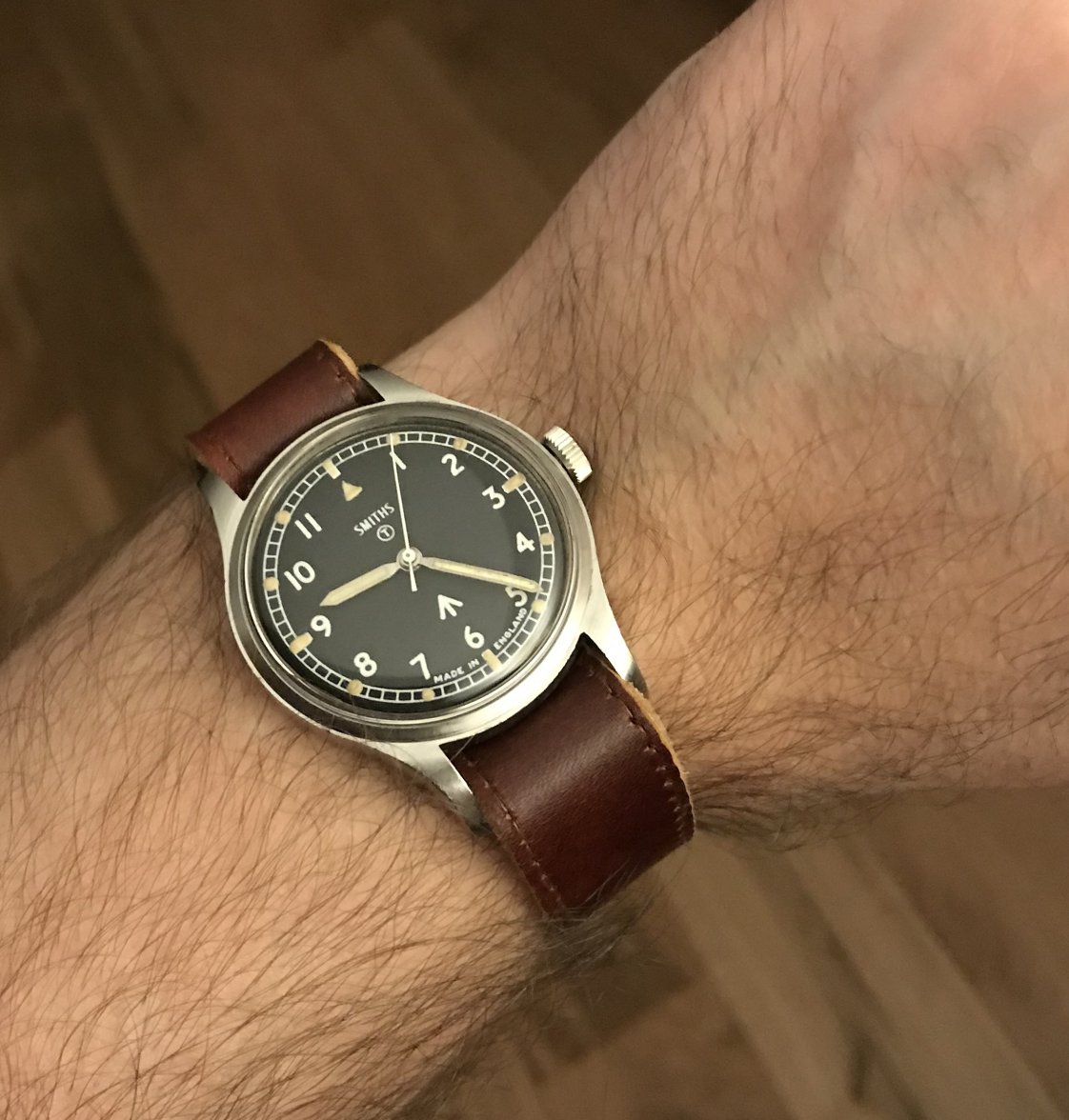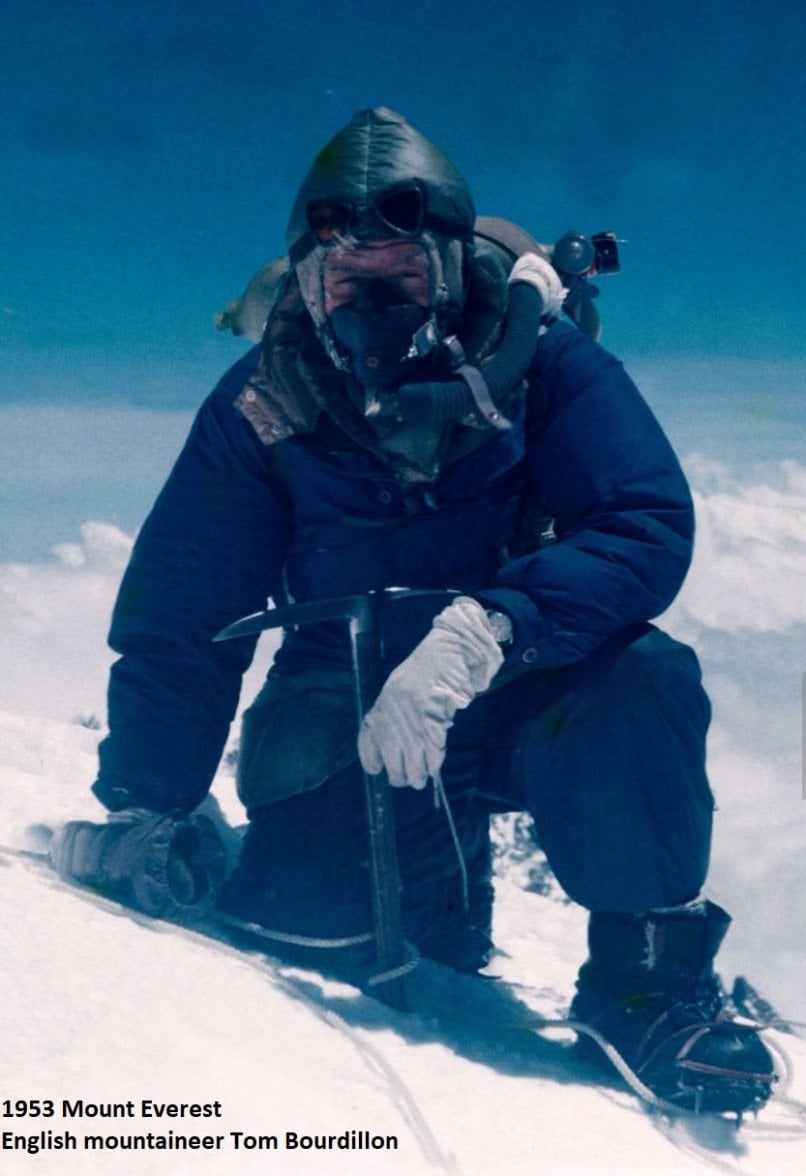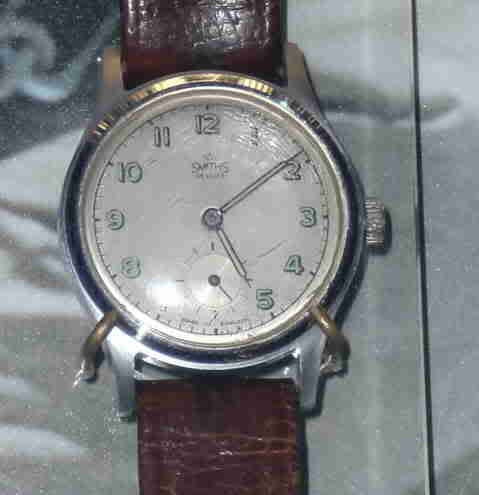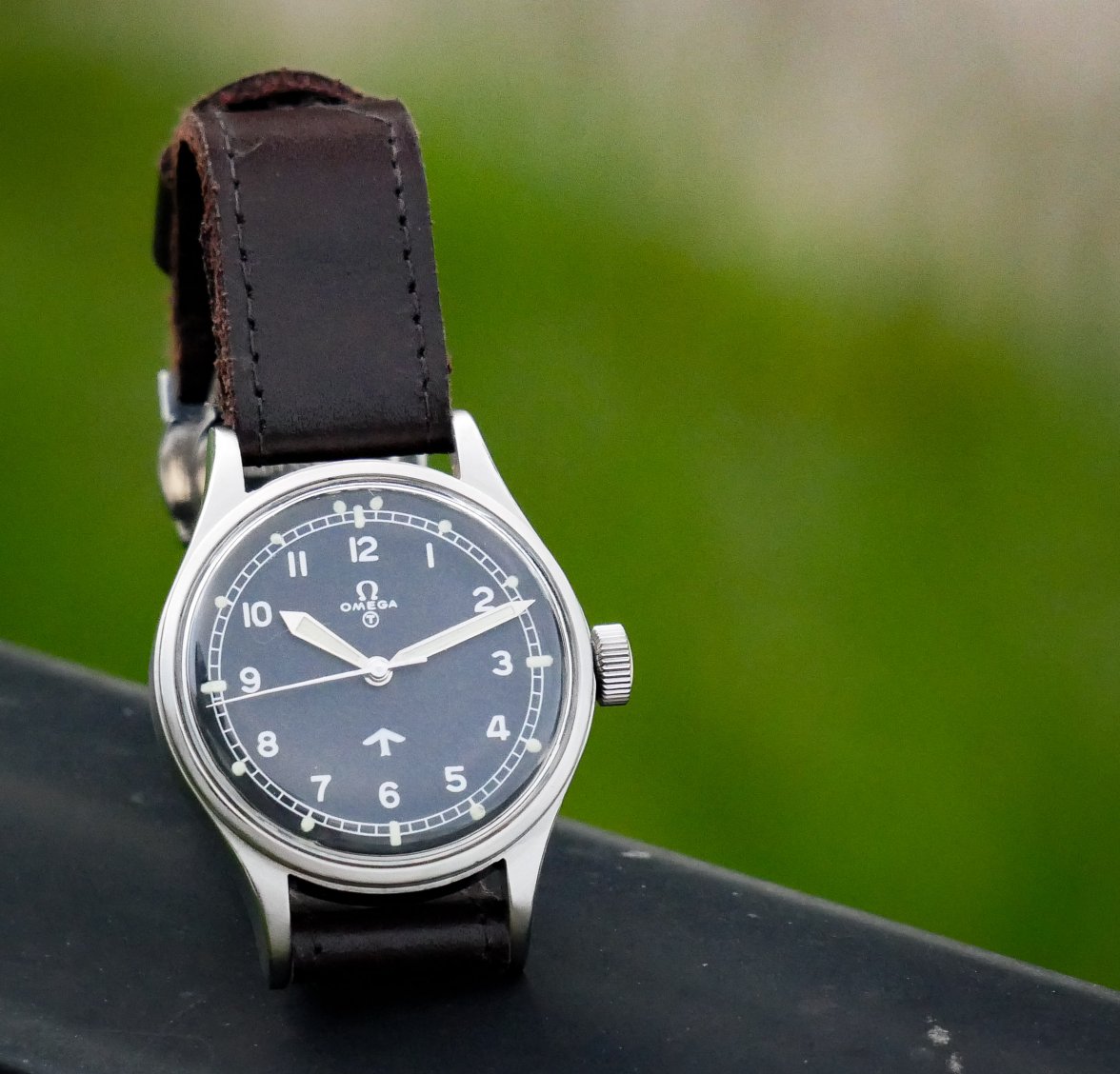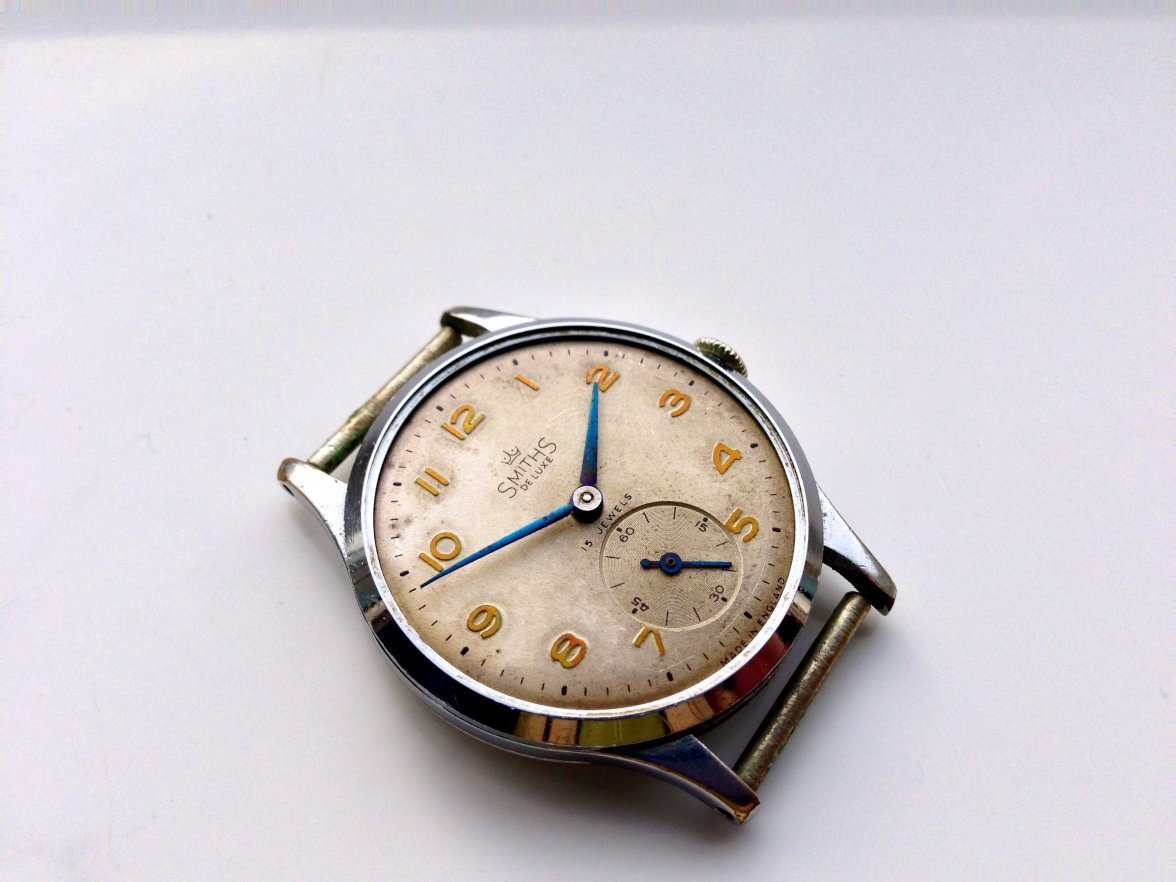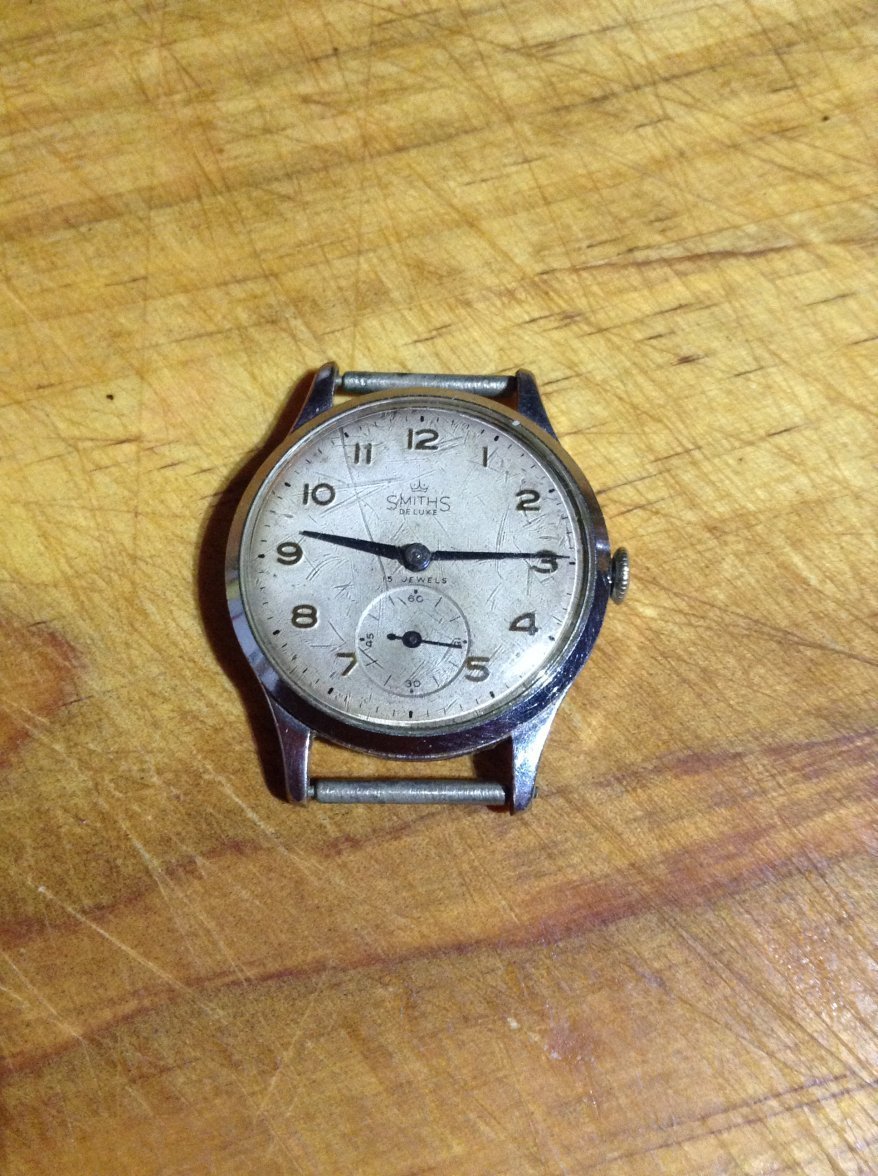Braindrain
·At a certain point in my collecting life, I’ve sort of stopped “searching” for particular watches. Sure, I’m always looking at ads and offers. Who isn’t? But, at this point, I really don’t have any particular watch that I just absolutely have to get. As a result, for my past 5 (or so) acquisitions, they’ve all found me. I’m about to share my latest.
A word of warning, this post enters into watch nerd nirvana.
It starts, like many stories, with a good friend of mine getting a watch. What was the watch? Something quite off the radar for most watch folk. A Smiths Everest reissue. The watch suited him very well. Being an avid mountain climber (who actually made it to Everest base camp and is going back to the Himalayas for more climbing), he knew his mountaineering watches. And, having recently purchased a vintage Mini with a Smiths clock, he decided that a Smiths Everest would be a perfect matchup. Here’s a pic of his watch. He also happens to be a pro photographer, so that helps. 😀

(Source: Julian Fok, IG @julianfok)
We had gotten into a bit of a conversation over whether a Smiths or Rolex had accompanied Sir Edmund Hillary to the top of Everest. (Yes, that age old question.) Regardless of the answer, I thought he had gotten a super neat watch. One that, if you’re my side of the pond, gets almost no recognition but represented a high point in British watchmaking.
Fast forward a few weeks and I come across this thread on MWR – “Smiths were the only watches worn on the summit of Everest in '53. The proof.” If you want to read this juggernaut, here’s the link.
While I’m not here to debate whether Smiths was truly the only watch on Hillary’s ascent to the top of Everest or not, there were two letters of note. One from Smiths (D.W. Barrett, the then-managing director of Smiths Clocks and Watches, as recorded in the September letters page) and one from the managing director of Rolex (taken from page 651 of the October '53 edition of The BHI Horological Journal).

(Source: M4tt @MWR)


(Source: M4tt @MWR)
Mind. Blown.
Ok, after digesting that incredible post, I decided to look into it some more. While I was very aware of Smiths from their 60s to 80s mil watches, I didn’t know much about their earlier history. I dug deeper, waded into David Boettcher’s blog (who also makes nice straps for fixed bar watches!), and found this nugget – “George Mallory's Watch”. His excellent blog report can be found here,
Much of the following information/images was sourced from VintageWatchstraps.com © David Boettcher
If you’re not familiar with George Mallory, he was the first European known to attempt Everest. He made 3 attempts in 1921, 1922, and 1924. Mallory and Irvine made an unplanned attempt to the summit on June 8, 1924, but, unfortunately, they did not survive. There was a report from an expedition member stating he saw them both within a few hundred feet of the summit. Wow! Exciting stuff. Really exciting! And far beyond my physical capabilities! But as a watch nerd, what watch was he wearing? Enquiring minds want to know!
Mallory’s body wasn’t found much later, until 1999, in fact. He was wearing a high grade Fontainemelon movement in a silver Borgel case with enamel dial. David’s blog goes into further detail and explanation as to what may have happened. Again, truly exciting stuff! But, the very last paragraph in David’s blog post is what captured my imagination and interest:
“In spite of the fact that both Sir Edmond Hillary and Tenzing Norgay wore Smiths Deluxe watches on the successful 1953 attempt on the Everest Summit, sponsored by Smiths and led by John Hunt, and that Norgay also wore a Rolex watch that had been issued to him on the unsuccessful 1952 Swiss expedition led by Raymond Lambert, which got to within 200 metres of the summit before turning back, leading to conflicting and confusing claims ever since, it seems likely that the first watch carried to the summit of Everest was George Mallory's Borgel wristwatch.”
Mind. Blown. Again.
While researching this information, I happen to come across a FS post. Not from just anyone. From a collector with whom I had previously bought 2 other watches. A very knowledgeable collector, I might add. The FS post was dated but I reached out to him. Could it, just possibly, still be available? Yes, was his answer! We sealed the deal and he promptly sent me this beauty.

The watch? A beautifully preserved Smiths trench watch in a silver Borgel case and a, what else, high grade FHF movement. The watch itself was in great condition. Small seconds hand probably needs a replacement but the rest was good. All hallmarks on caseback perfectly preserved.
What’s interesting to note, from David’s blog, is that the “high grade FHF movement” that Mallory was using wasn’t any FHF movement. It was a little different. Here’s a pic of Mallory’s watch and movement (© Rick Reanier/Jochen Hemmleb) :


Per David’s blog, it was a hybrid from what he coined FHF1 and FHF2. As luck would have it, my Smiths trench had the exact same movement:

The watch gods have smiled on me. ….. But wait, there’s more! The story continues!

Per the caseback hallmarks, it seems this watch was assayed in London, imported by George Stockwell, and - most importantly - made in 1915. Not only did all these hallmarks coincide with Mallory’s watch, but, as a milwatch enthusiast, that also really got me excited. I had, in my hands, a Smiths “Allies watch”. Issued during the Great War and most likely bought to be used on the field. Here’s an advert of such a watch.

(Source: David Boettcher @vintagewatchstraps.com)
An interesting quirk of the Great War is that, in the early days, soldiers/officers were “encouraged” to purchase their own wristwatch. Moreover, most collectors are fairly sure luminous dialed officers’ (trench) watches were bought for field use because of documents like this:

(Source: David Boettcher @vintagewatchstraps.com)
Note how a luminous wrist watch is the very first item noted. So much story for such an old watch!
Which brings me to current day. As watch collectors, we all have our own personal journey. Sometimes, just sometimes, we find some real gems that don’t necessarily need to cost tens of thousands, but just have that personal connection or interest to make it invaluable. I am very fortunate to have found such a watch.
After running the watch for 24 hours and timing it against my cell phone, it has kept time “to the minute” and held a power reserve of 30 hours. For a 100+ year old movement, that is excellent indeed! No service needed there. My very next step is to find a proper seconds hand. But, hey, that’s the easy-ish part!
I hope you enjoyed the long ramblings of a very excited watch nerd.
Thanks for reading.
Kendall
NB: Again, I stress that the point of my post was to share how I discovered this watch - and NOT to debate whether Smiths or Rolex was truly the first watch to be worn on the summit of Everest. I’m not the author of the MWR post and definitely did not contribute to the research but, if you have additional clarifying info, I strongly suggest you post in that thread.
A word of warning, this post enters into watch nerd nirvana.
It starts, like many stories, with a good friend of mine getting a watch. What was the watch? Something quite off the radar for most watch folk. A Smiths Everest reissue. The watch suited him very well. Being an avid mountain climber (who actually made it to Everest base camp and is going back to the Himalayas for more climbing), he knew his mountaineering watches. And, having recently purchased a vintage Mini with a Smiths clock, he decided that a Smiths Everest would be a perfect matchup. Here’s a pic of his watch. He also happens to be a pro photographer, so that helps. 😀

(Source: Julian Fok, IG @julianfok)
We had gotten into a bit of a conversation over whether a Smiths or Rolex had accompanied Sir Edmund Hillary to the top of Everest. (Yes, that age old question.) Regardless of the answer, I thought he had gotten a super neat watch. One that, if you’re my side of the pond, gets almost no recognition but represented a high point in British watchmaking.
Fast forward a few weeks and I come across this thread on MWR – “Smiths were the only watches worn on the summit of Everest in '53. The proof.” If you want to read this juggernaut, here’s the link.
While I’m not here to debate whether Smiths was truly the only watch on Hillary’s ascent to the top of Everest or not, there were two letters of note. One from Smiths (D.W. Barrett, the then-managing director of Smiths Clocks and Watches, as recorded in the September letters page) and one from the managing director of Rolex (taken from page 651 of the October '53 edition of The BHI Horological Journal).

(Source: M4tt @MWR)


(Source: M4tt @MWR)
Mind. Blown.
Ok, after digesting that incredible post, I decided to look into it some more. While I was very aware of Smiths from their 60s to 80s mil watches, I didn’t know much about their earlier history. I dug deeper, waded into David Boettcher’s blog (who also makes nice straps for fixed bar watches!), and found this nugget – “George Mallory's Watch”. His excellent blog report can be found here,
Much of the following information/images was sourced from VintageWatchstraps.com © David Boettcher
If you’re not familiar with George Mallory, he was the first European known to attempt Everest. He made 3 attempts in 1921, 1922, and 1924. Mallory and Irvine made an unplanned attempt to the summit on June 8, 1924, but, unfortunately, they did not survive. There was a report from an expedition member stating he saw them both within a few hundred feet of the summit. Wow! Exciting stuff. Really exciting! And far beyond my physical capabilities! But as a watch nerd, what watch was he wearing? Enquiring minds want to know!
Mallory’s body wasn’t found much later, until 1999, in fact. He was wearing a high grade Fontainemelon movement in a silver Borgel case with enamel dial. David’s blog goes into further detail and explanation as to what may have happened. Again, truly exciting stuff! But, the very last paragraph in David’s blog post is what captured my imagination and interest:
“In spite of the fact that both Sir Edmond Hillary and Tenzing Norgay wore Smiths Deluxe watches on the successful 1953 attempt on the Everest Summit, sponsored by Smiths and led by John Hunt, and that Norgay also wore a Rolex watch that had been issued to him on the unsuccessful 1952 Swiss expedition led by Raymond Lambert, which got to within 200 metres of the summit before turning back, leading to conflicting and confusing claims ever since, it seems likely that the first watch carried to the summit of Everest was George Mallory's Borgel wristwatch.”
Mind. Blown. Again.
While researching this information, I happen to come across a FS post. Not from just anyone. From a collector with whom I had previously bought 2 other watches. A very knowledgeable collector, I might add. The FS post was dated but I reached out to him. Could it, just possibly, still be available? Yes, was his answer! We sealed the deal and he promptly sent me this beauty.

The watch? A beautifully preserved Smiths trench watch in a silver Borgel case and a, what else, high grade FHF movement. The watch itself was in great condition. Small seconds hand probably needs a replacement but the rest was good. All hallmarks on caseback perfectly preserved.
What’s interesting to note, from David’s blog, is that the “high grade FHF movement” that Mallory was using wasn’t any FHF movement. It was a little different. Here’s a pic of Mallory’s watch and movement (© Rick Reanier/Jochen Hemmleb) :


Per David’s blog, it was a hybrid from what he coined FHF1 and FHF2. As luck would have it, my Smiths trench had the exact same movement:

The watch gods have smiled on me. ….. But wait, there’s more! The story continues!

Per the caseback hallmarks, it seems this watch was assayed in London, imported by George Stockwell, and - most importantly - made in 1915. Not only did all these hallmarks coincide with Mallory’s watch, but, as a milwatch enthusiast, that also really got me excited. I had, in my hands, a Smiths “Allies watch”. Issued during the Great War and most likely bought to be used on the field. Here’s an advert of such a watch.

(Source: David Boettcher @vintagewatchstraps.com)
An interesting quirk of the Great War is that, in the early days, soldiers/officers were “encouraged” to purchase their own wristwatch. Moreover, most collectors are fairly sure luminous dialed officers’ (trench) watches were bought for field use because of documents like this:

(Source: David Boettcher @vintagewatchstraps.com)
Note how a luminous wrist watch is the very first item noted. So much story for such an old watch!
Which brings me to current day. As watch collectors, we all have our own personal journey. Sometimes, just sometimes, we find some real gems that don’t necessarily need to cost tens of thousands, but just have that personal connection or interest to make it invaluable. I am very fortunate to have found such a watch.
After running the watch for 24 hours and timing it against my cell phone, it has kept time “to the minute” and held a power reserve of 30 hours. For a 100+ year old movement, that is excellent indeed! No service needed there. My very next step is to find a proper seconds hand. But, hey, that’s the easy-ish part!
I hope you enjoyed the long ramblings of a very excited watch nerd.
Thanks for reading.
Kendall
NB: Again, I stress that the point of my post was to share how I discovered this watch - and NOT to debate whether Smiths or Rolex was truly the first watch to be worn on the summit of Everest. I’m not the author of the MWR post and definitely did not contribute to the research but, if you have additional clarifying info, I strongly suggest you post in that thread.
